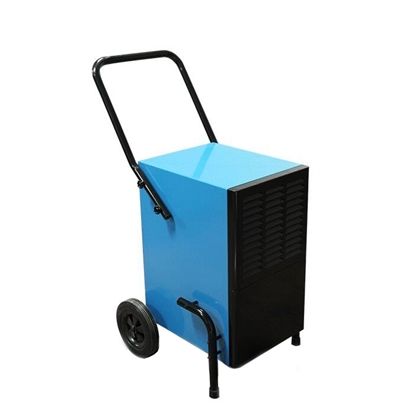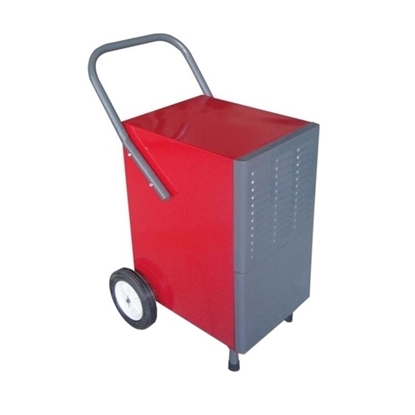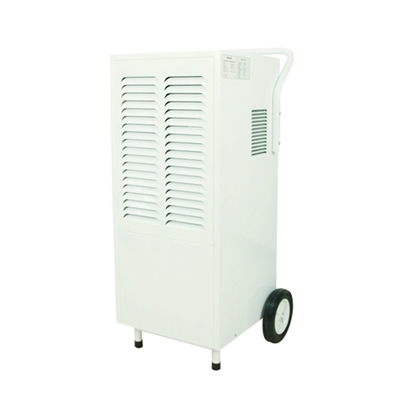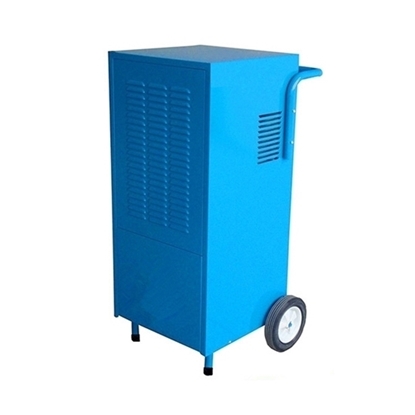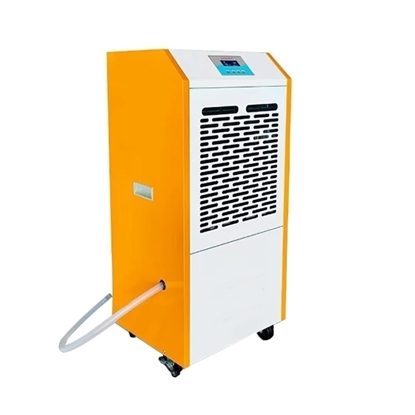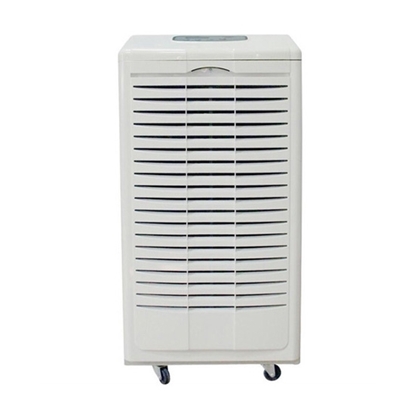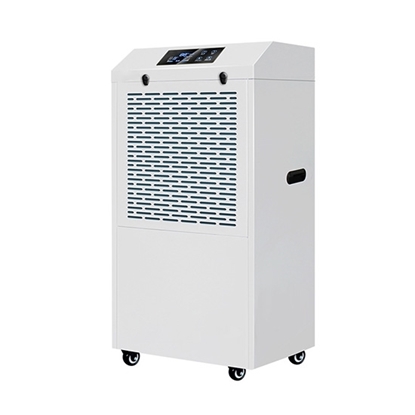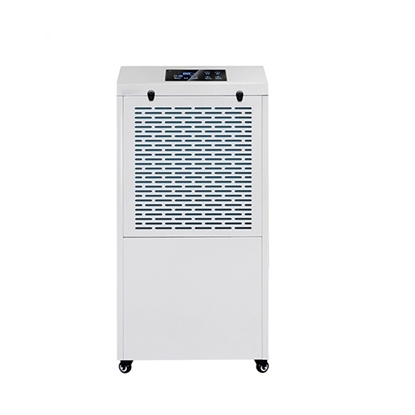Dehumidifier
Commercial Dehumidifier 110-Pint (55L) for 500 Sq. Ft
Commercial Dehumidifier 120-Pint (60L) for 700 Sq. Ft
Commercial Dehumidifier 160-Pint (80L) for 800 Sq. Ft
Commercial Dehumidifier 250-Pint (120L) for 1600 Sq. Ft
Industrial Dehumidifier 190-Pint (90L) for 1200 Sq. Ft
Industrial Dehumidifier 330-Pint (158L) for 1900 Sq. Ft
Industrial Dehumidifier for Basement, 190-Pint (90L), 1500 Sq. Ft
High Power Industrial Dehumidifier, 330-Pint (156L), 2500 Sq. Ft
A dehumidifier is an air conditioning device which reduces and maintains the level of humidity in the air. This is done usually for health or thermal comfort reasons, or to eliminate musty odor and to prevent the growth of mildew by extracting water from the air.
Air dehumidifier can be used for household, commercial, or industrial applications. Large dehumidifiers are used in commercial buildings such as indoor ice rinks and swimming pools, as well as manufacturing plants or storage warehouses.
Best commercial & industrial dehumidifier for sale. The dehumidifiers have water removal capacity up to 110 Pint (55L), 120 Pint (60L), 160 Pint (80L) per day etc., which can handle moisture removal in damp environments in an area up to 500 sq. ft, 700 sq. ft, 800 sq. ft or larger room. Featuring low noise, energy saving and high efficiency, the dehumidifier comes with wheels for easy moving, and water tank & drain outlet for continuous draining. The ac dehumidifiers are ideal for commercial and industrial environments like hotel, garage, basements, cellars, warehouses, workshops and so on.
Why Need A Dehumidifier For Bathroom?
Bathrooms are naturally warm, moist places, ideal for mold. Bathwater may splash on the floor and a hot shower steams up the whole bathroom. There are also plenty of pipes that may drip or leak. In addition, bathrooms are often poorly ventilated. Many bathrooms have no windows, there is usually only one door, and that door may be closed much of the time. The lack of ventilation increases the likelihood of mold in bathrooms. If you have an exhaust fan in the bathroom, turning it on every time you shower will reduce moisture in the air and lessen the need for a dehumidifier. If you don't have an exhaust fan, though, or if you've discovered mold despite using an exhaust fan, you may want to consider a portable dehumidifier for bathroom.
Dehumidifier vs. Air conditioner:
 Warm and cool air movement. Air conditioners have fan systems designed to circulate room temperature air over the cooling coils and pump out a chilly blast. Dehumidifiers have a fan for pulling in the moist air and expelling dry air, but the warm air off the condenser? Air conditioners move this outside. Dehumidifiers dump the warm air inside, negating any cooling effect.
Warm and cool air movement. Air conditioners have fan systems designed to circulate room temperature air over the cooling coils and pump out a chilly blast. Dehumidifiers have a fan for pulling in the moist air and expelling dry air, but the warm air off the condenser? Air conditioners move this outside. Dehumidifiers dump the warm air inside, negating any cooling effect.- Moisture. The two machines deal with moisture very differently as well. Air conditioners and portable dehumidifiers both condense moisture on the cooling coils. Air conditioners pool the condensate in a pan which drains to the exterior. They can have a drip edge or drainage tubes, but the basic thrust is the moisture leaves the house. Dehumidifiers are designed to pull water from the air. Commercial dehumidifiers generally have a water reservoir with a hose attachment port for dedicated drainage. The funny thing about air conditioners and large portable dehumidifiers is that their functions are so wildly different that most folks don't realize that the heat transfer mechanic is identical. However, they are nearly identical in form if not function.
- Function. While an air conditioner is primarily used for removing hot air and introducing cold air in a room, it also removes humidity from the air as a consequence. But the volume of moisture removed is not in such a great quantity so as to have a noticeable effect on the room atmosphere. This is where a portable ac dehumidifier is more efficient, it can remove a high amount of moisture from the room. While the room may naturally drop when humidity is removed, portable room dehumidifiers do not throw any cool air into a room.
Dehumidifier For Industrial Use:

Dehumidification systems remove unwanted moisture from a building's internal environment to help control its atmosphere's relative humidity and dew point. In commercial applications, dehumidifiers help contribute to a pleasant work environment, aid in room temperature regulation, and help control condensation causing mold or mildew formation. In industrial applications, dehumidification systems aid in controlling your product's moisture content, enable smooth process operations, and maximize production efficiency.
When controlling building relative humidity using a properly sized and engineered dehumidification system can go a long way in protecting product quality, in some cases even making the difference between successful and failed operations. ATO industrial dehumidifiers can control dew point down to 50% in some circumstances.
Compared with smaller dehumidification systems, industrial strength dehumidifiers have a higher moisture removal capacity, rugged construction and incorporate necessary fail-safes, ensuring dependable operation and meeting the demanding conditions of industrial applications. Dehumidifiers typically require permanent installation and ensure complete room air flow through ducting, and are usually integrated with a facility's existing HVAC system.
Dehumidifier FAQ:
- Can I open the door and window when the dehumidifier is running? It is recommended not to open doors and windows while the dehumidifier is working. In fact, this is just like using the air conditioner. It also needs to close the doors and windows when the dehumidifier is turned on. If the doors and windows are open, the dehumidification effect will naturally not be very good.
- Will a dehumidifier kill mold? Mold growth occurs in the place of continuous humidity. Controlling humidity will help solve mold problems, but it will not completely eliminate them. When the relative humidity is usually 60% or more, the mold will remain active. If you reduce the humidity by 50% with a dehumidifier and keep it at this level, the mold will become inactive and the situation will not get worse. However, the mold does not die, it is just inactive, and occasionally it produces mold spores. Therefore, the dehumidifier can remove moisture, which is helpful to prevent it but not kill it.
- What dehumidifier should I use for an attic or crawlspace? Attics and crawl spaces can present challenges for removing humidity, but it is crucial to dehumidify those spaces to prevent mold and wood rot. For a large attic, a regular compressor dehumidifier is a good solution. For smaller enclosed spaces, there are lower capacity dehumidifiers that can do the job as long as you can get an extension cord into the space. For really tight or tiny crawl spaces, using a desiccant might be your only option in lieu of using a dehumidifier.
- Can I clean the dehumidifier after using it for a long period? It needs to be cleaned. The air duct (air inlet and outlet) or filter should be cleaned regularly. If the dehumidifier is used for a long time, the air inlet is easily blocked, and the air inlet is not smooth, which directly affects the dehumidification effect. Therefore, the air duct filter of the machine should be cleaned regularly, and it is recommended to clean it every two weeks. When cleaning the filter, make sure the machine is cut off the power to avoid problems in removing the filter screen.
- Should a dehumidifier run all the time? The operation concept mentioned here has two meanings: one refers to the running operation and the other refers to the operation in the power-on standby state. The current dehumidifier is not running in the "dehumidification operation" mode for 24 hours, but only for 24-hour power on, repeatedly running between the two modes of standby and dehumidification operation according to the set humidity range. The intelligent dehumidifier operates according to the set humidity range. When the humidity of the room reaches the set humidity, the dehumidification operation system will be automatically turned off. This saves electricity costs and minimizes the loss of the dehumidifier itself.

